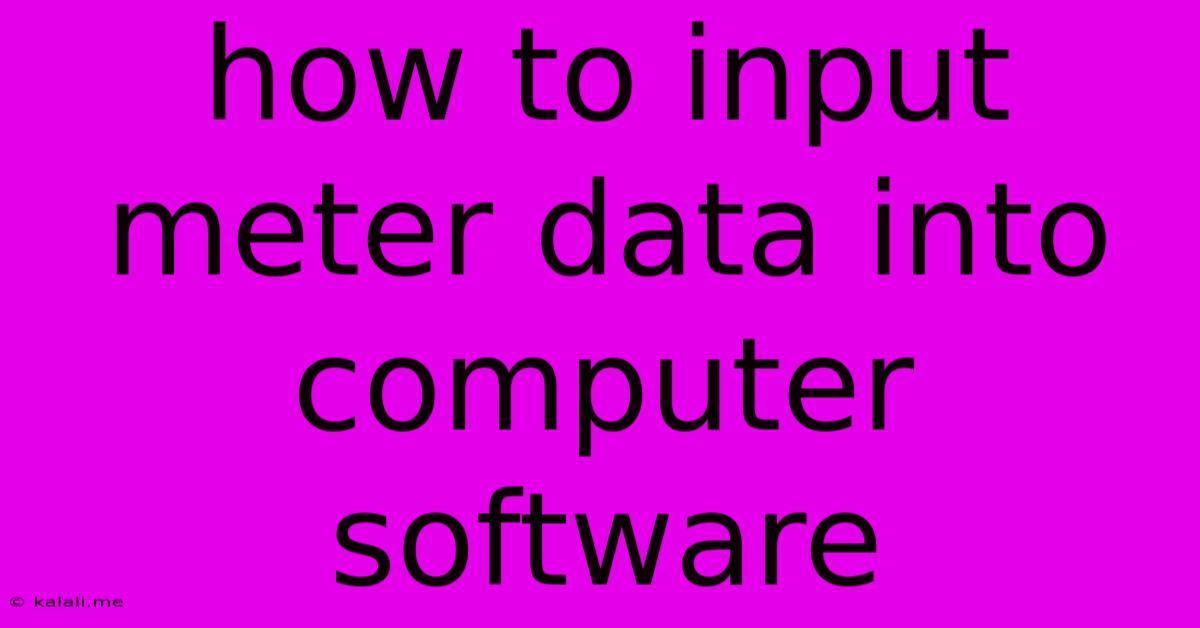How To Input Meter Data Into Computer Software
Kalali
Jun 08, 2025 · 3 min read

Table of Contents
How to Input Meter Data into Computer Software: A Comprehensive Guide
Meta Description: Learn how to efficiently input meter readings into computer software. This guide covers various methods, troubleshooting tips, and best practices for accurate data entry. Improve data management and analysis with our step-by-step instructions.
Manually inputting meter data can be a tedious and error-prone process. However, with the right approach and understanding of your software, you can streamline this task and ensure data accuracy. This guide provides a comprehensive walkthrough of how to effectively input meter data into computer software, regardless of the specific application you are using.
Understanding Your Meter Data and Software
Before diving into the input process, it's crucial to understand the data you're working with and the capabilities of your software. Different meters provide varying information, including:
- Meter ID: A unique identifier for each meter.
- Reading Type: This could be gas, electricity, water, or another utility.
- Reading Value: The actual meter reading (e.g., kilowatt-hours, cubic feet, gallons).
- Date and Time: When the reading was taken.
- Additional Data: Some meters may record additional information like temperature or pressure.
Your software should have a user interface designed for efficient data entry. Familiarize yourself with its features, including:
- Data Entry Fields: Locate the specific fields for each data point (Meter ID, Reading Value, Date, etc.).
- Data Validation: Many software programs include validation checks to prevent incorrect data entry (e.g., preventing negative readings or non-numeric values).
- Import/Export Options: Explore options for bulk data import using files like CSV or Excel spreadsheets. This is significantly faster than manual entry for large datasets.
- Error Handling: Understand how the software handles errors and provides feedback.
Methods for Inputting Meter Data
The specific steps will vary depending on your software, but the general principles remain consistent. Here are the most common methods:
-
Manual Data Entry: This involves typing each data point into the corresponding field within the software. While time-consuming, it's suitable for small datasets or when you need precise control over each entry. Double-check each entry to minimize errors.
-
Bulk Upload via Spreadsheet: This is the most efficient method for large datasets. Export your meter readings into a spreadsheet (CSV or Excel) with columns matching the software's input fields. Most software allows importing these files directly, significantly speeding up the process. Ensure the spreadsheet is formatted correctly to avoid import errors.
-
Automated Meter Reading (AMR) Systems: For advanced setups, AMR systems automatically transmit meter readings to your software, eliminating manual input entirely. This requires specialized hardware and software integration.
Troubleshooting Common Issues
During the input process, you may encounter some issues:
-
Data Format Errors: Ensure your data is in the correct format (e.g., numbers for reading values, dates in the correct format). Incorrect formatting will often prevent data from being accepted.
-
Data Validation Errors: Pay close attention to any error messages displayed by the software. These often pinpoint specific issues with your data entry.
-
Software Glitches: If you encounter persistent problems, try restarting the software or your computer. Contact your software provider's support team if the issue persists.
Best Practices for Accurate Data Entry
-
Double-Check Your Work: Always verify the accuracy of your input data. Errors can lead to inaccurate reports and analysis.
-
Use Consistent Units: Maintain consistent units of measurement throughout your data.
-
Regular Data Backup: Back up your meter data regularly to prevent data loss.
-
Documentation: Keep detailed records of your data entry process, including any changes or corrections made.
By following these guidelines and adapting them to your specific software and data, you can effectively and efficiently input meter data into your computer software, ensuring data accuracy and facilitating robust analysis. Remember to always consult your software's documentation for detailed instructions and support.
Latest Posts
Latest Posts
-
Where Do I Recharge Fire Extinguisher
Jun 08, 2025
-
Failed To Start Docker Service Unit Docker Service Not Found
Jun 08, 2025
-
How To Draw A Quarter Rest
Jun 08, 2025
-
How Did Moses Know Aaron Was His Brother
Jun 08, 2025
-
Does More Sharpness Mean Higher Resolution
Jun 08, 2025
Related Post
Thank you for visiting our website which covers about How To Input Meter Data Into Computer Software . We hope the information provided has been useful to you. Feel free to contact us if you have any questions or need further assistance. See you next time and don't miss to bookmark.